Merchant ships are the lifeblood of the global economy. They move an immense number of goods that feed billions of people around the world.
There are an estimated 105,500 vessels floating in many parts of the seas right now according to UNCTAD statistics. We categorize them into different types of ships according to their function.
Ships come in various shapes and sizes. Their crew have special skills depending on the vessels they work with.
Some ships trade or transport goods like containers, bulk carriers, cars, and liquid cargoes. These are merchant ships.
Types of Ships
Due to their immense variations, these types of ships create an ecosystem of their own.
Naming them is very straightforward.
We call a vessel carrying containers as a container ship. Vessels conducting research as research vessels. Ships capable of drilling the earth’s crust as drill ships.
So on and so forth.
This article will be a series. First, let’s take a look at the types of merchant ships to have a greater understanding of them.
What are Merchant Ships?
As the name suggests, merchant vessels are watercraft engaged in transporting merchandise. In this case, they carry different cargoes from one place to another.
Hence, they are also called commercial ships or trading vessels.
These cargoes can either be solid, liquid, gas, or even passengers for hire. We import most of the things we use or consume through the service of merchant ships.
Under merchant vessels, we have three sub-classes. These are Dry Cargo, Liquid Cargo, and Passenger Ships.
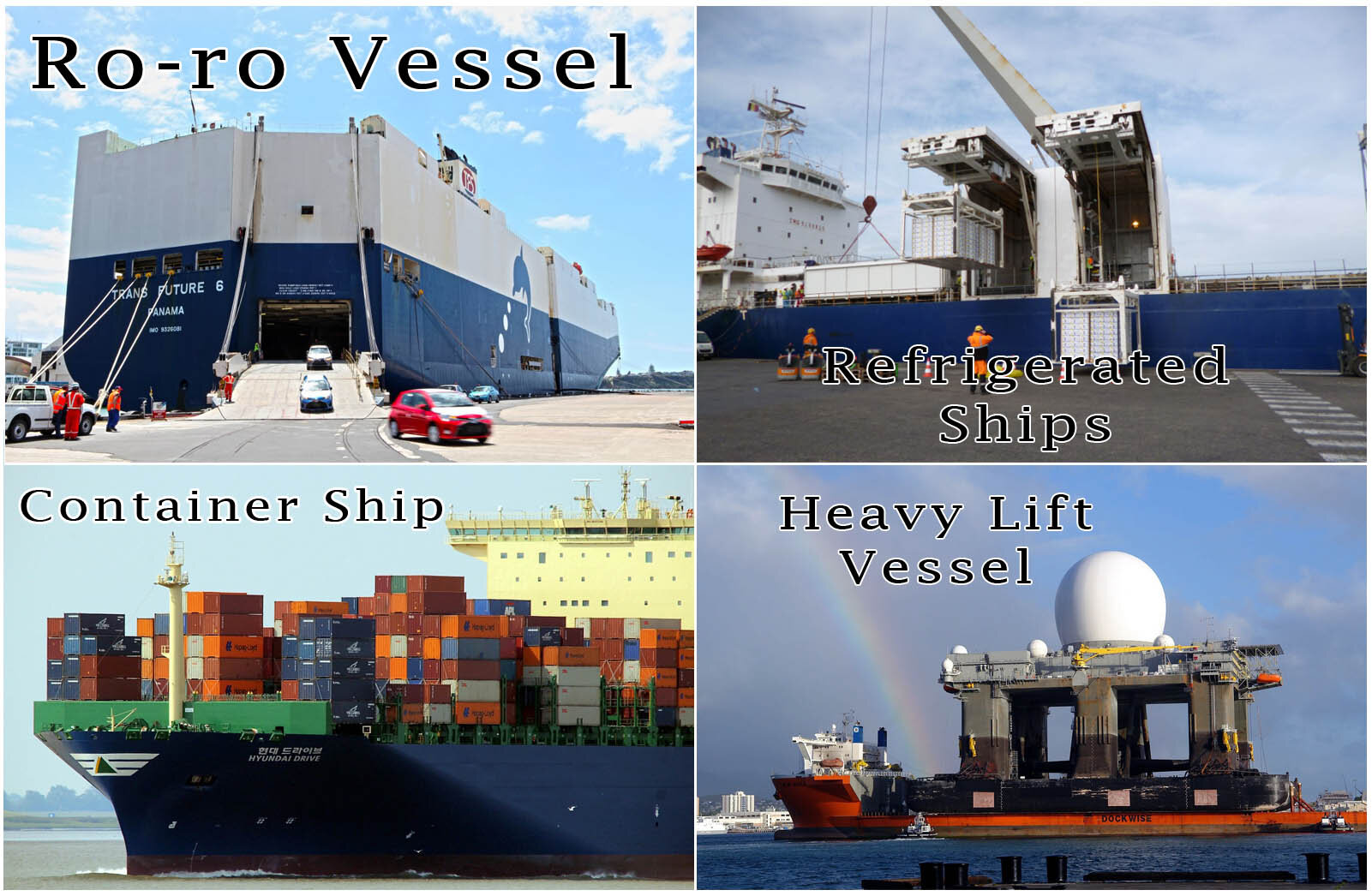
Dry Cargo Ships
Such vessels carry, well, dry goods.
These cargoes include grains, coal, containers, cattle, windmills, helicopters, and everything dry you could think about. Even the phones in your hand or that computer in your desk are dry cargoes.
Thus, merchant ships in this category are also called Dry Bulk Ships or Dry Cargo Vessels.
1. Container Vessels
These types of merchant ships carry cargo in containers or “boxes”. The goods are stowed inside an intermodal container that has standardized dimensions.
A single container ship could transport various products inside those boxes. iPhones, bikes, Lambo, speakers, and even explosives fit into those shipping containers.
2. Ro-ro Vessels
Roll-on/Roll-off ships or Ro-ro got their name from the method they use to load or unload their cargo.
These vessels are not fitted with lifting equipment. Instead, they use wide ramps in their stern to “roll on and off” their cargoes.
Their cargoes are mostly cars that drivers park inside the ship or to the terminal during unloading.
And yes, they also carry products without wheels. They place these “non-wheeled” cargoes on trailers or wheeled equipment to secure them inside.
3. Heavy Lift Ships
Some cargoes are too big they don’t fit in containers, tanks, or any conventional means of stowage.
In the shipping business, size is usually proportional to weight.
This is where heavy lift ships come in. We classify them into three:
- Semi-submersible heavy transport vessels– ships that submerge their deck using a special ballasting system so their cargo can be loaded using the float on/ float off method. Once the cargo is positioned, it discharges its ballast making the deck and its cargo float above the waterline.
- Open Deck Cargo Ships– Uses onboard deck crane or the cargo’s own power (wheels) to move itself to the ship. They are similar to Ro-ro vessels which use stern ramps and superstructure positioned forward to make way for cargo capacity.
- Project Ships– these are non-submersible heavy lift ships designed to transport extremely large and heavy objects like windmills, bridge parts, ship parts, container cranes, yachts, etc.
- Dock ships– are ships that can load their cargo using three different methods. They have stern ramps where cargoes can roll-on/ roll-off. Loading or unloading can also be done using cranes or the lift-on/lift-off method. Lastly, their decks can be submerged underwater through the float-in/float-out technique.
These types of HLVs carry massive cargo such as complete parts of factories, drilling rigs, heavy or bulky objects, and other similar structures.
Refrigerated Ships
Also called Reefers, these types of merchant ships carry fruits, vegetables, meat, fish, and other frozen products.
Old Reefers have refrigeration systems installed on board equipped with insulated holds. Stevedores load the freight inside and cool it down to its desired temperature.
Today is different. These vessels carry refrigerated containers. The ship supplies them with electricity using the ship’s power.
These containers have their own refrigeration system.
5. Livestock Carrier
Also called Cattle Ships, these vessels transport livestock like sheep, horses, cows, goats, and camels.
Due to the nature of its cargo, they have special regulations in place. The ship has complete facilities with what these animals need to survive the voyage.
Cattle ships must have a functioning stable system, floor system, and manure discharge system.
We were once at an anchorage in Las Palmas and there was this awful smell outside the accommodation. Looking around, we found where it was coming from.
There was a cattle carrier on our starboard side also at anchor.
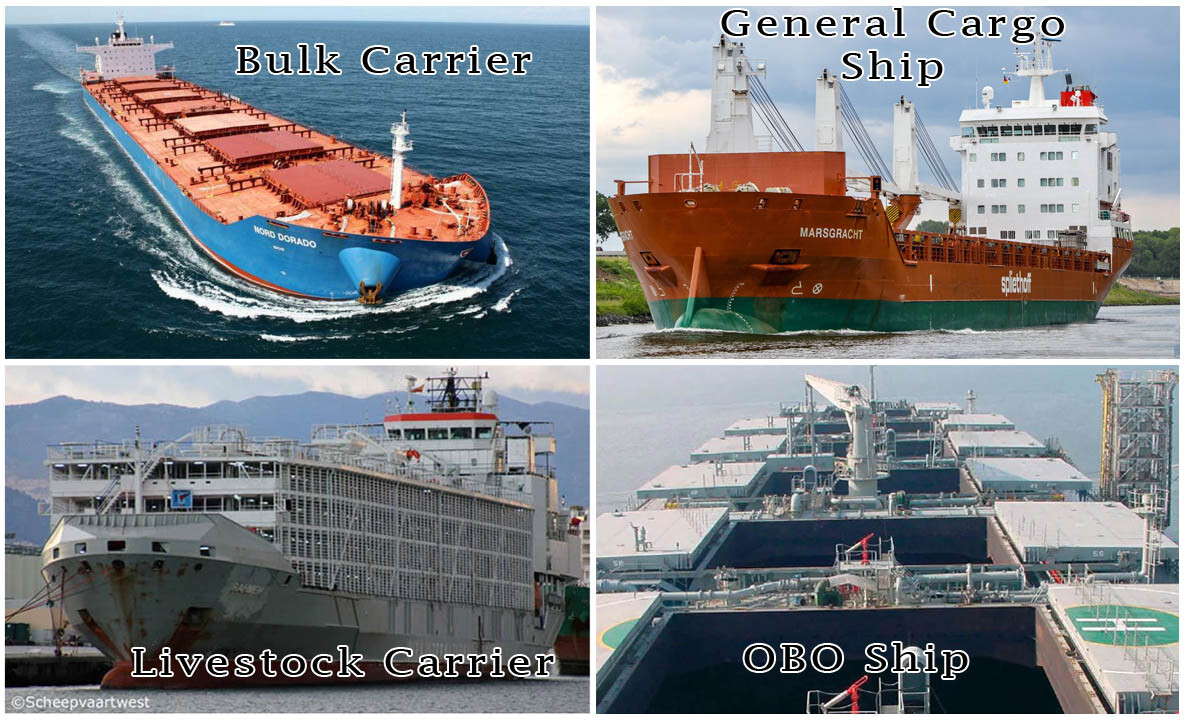
6. Bulk Carrier
Bulk carriers are types of ships that carry loose cargo in bulk. Loose cargoes are products that do not require packaging making them ideal for bulk transport.
Bulk carriers usually load or discharge their cargo by the use of grabs or conveyors.
Major bulk cargoes include grain, ore, and coal.
7. OBO Carrier
A combination carrier or OBO is another special type of merchant vessel that carries Ore, Bulk, and Oil.
By the name itself, it can carry oil and ore in bulk. They are a hybrid between dry and liquid cargo carriers.
This dual-purpose operation provides them with tanker equipment and ore-carrying capabilities.
8. General Cargo Vessel
Also called a Multi-purpose vessel or MPV, this type of ship doesn’t fall into any specific category as it can transport a wide variety of products.
Examples of their cargoes are steel, timber, minerals, vehicular parts, grains, machinery, and many others.
Some of these ships have heavy lift cranes enabling them to take the function of a heavy lift vessel.
9. Log Ship
Also known as Lumber Carriers, these ships carry lumber or wood and other wooden commodities.
They are very easy to spot as the timbers are stacked up on deck.
One of my seafarer friends shared his experience in a log ship.
Since these logs come from forests, snakes are occasionally transported with them. The charterer gave them extra compensation for every snake they captured.
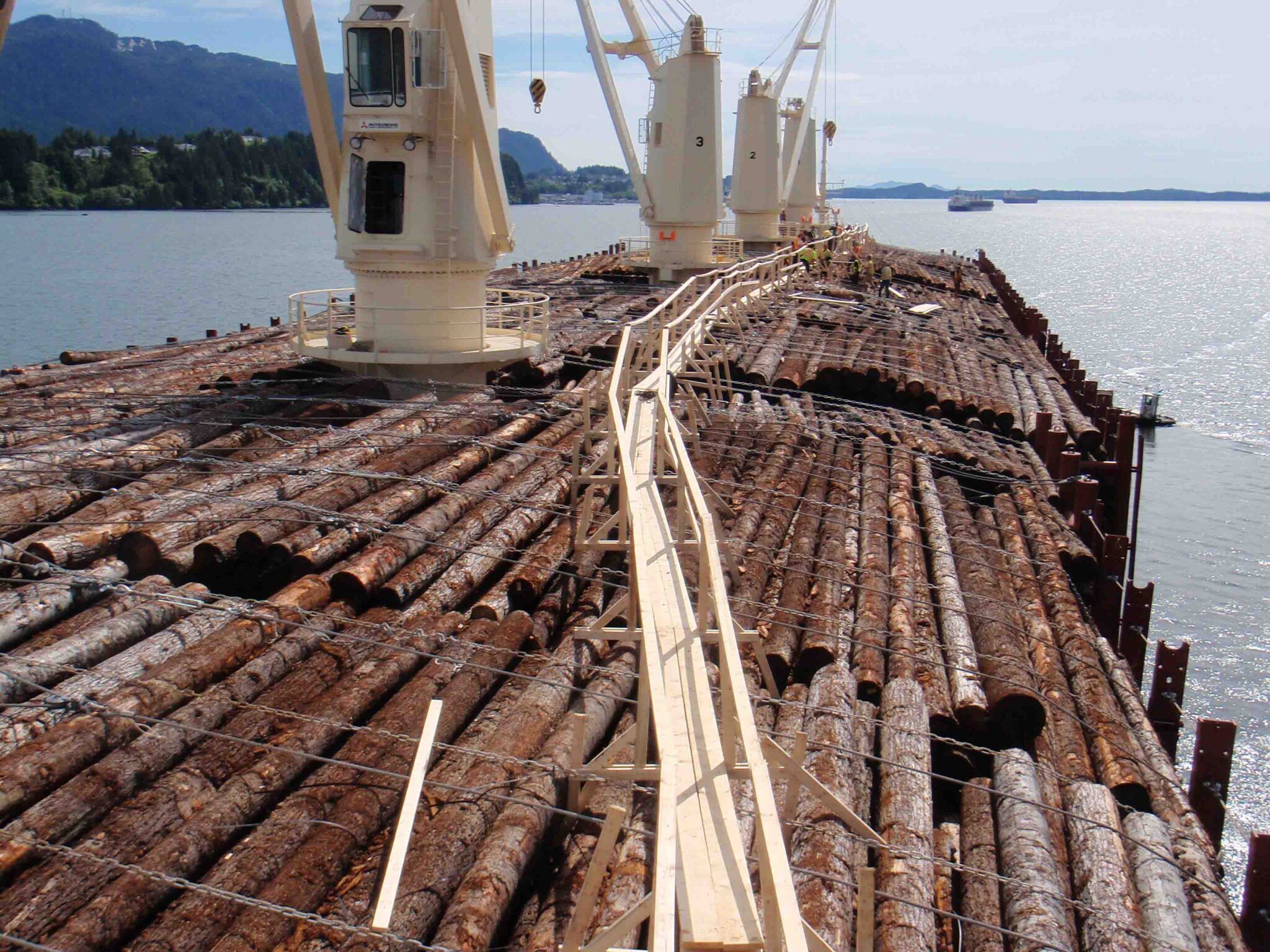
Liquid Cargo
We just finished tackling the kinds of dry cargo ships. Now, let’s take a look at another type of merchant vessel that transports liquid cargo in bulk.
We call them tanker ships and they carry a wide variety of liquid products.
Here’s a pro tip. Seafarers’ salaries in tankers are usually bigger than others in the merchant shipping industry.
10 Crude Carriers
Crude oil is a fossil fuel deposit which consists of hydrocarbon. It is the most basic commodity in the petroleum industry.
Crude carriers are ships designed to carry crude oil. They are further classified according to their size and deadweight.
Due to their enormous size, they are also used as storage for crude oil.
The largest ship-owning countries have crude tankers in their fleet.
11. Shuttle Tankers
There are areas where the oil harvested in the middle of the sea doesn’t have a connecting pipeline going to shore facilities.
This is where shuttle tankers come in.
Shuttle tankers are types of merchant ships that transport crude oil from an off-shore oil field to a refinery on shore.
They have what we call a bow loading system (BLS) which connects to a pipeline attached to a buoy in the middle of the sea or oil field.
12. Product Tankers
Crude oil is a very useful raw material.
We can refine them into products like gasoline, diesel, naphtha, bunker, lubricating oil, jet fuel, and many others. To transport these to other places or countries, businesses use Product Tankers.
They carry derivatives of crude oil with differing grades but not crude oil itself. Many of these products are flammable and thus, tankers use inert gas to control that risk while transporting them.
Even with that equipment, chipping in tanker ships may not be allowed especially during loaded conditions.
Since their cargoes are consumer-ready, the construction of these ships is big enough to pass inside waterways and enter into ports.
Product tankers can carry two kinds of petroleum cargoes.
Clean petroleum products (CPP) are more refined and ready to use. Dirty petroleum products (DPP) are black oils like heavy fuel oils and asphalt. These cargoes normally require heating.
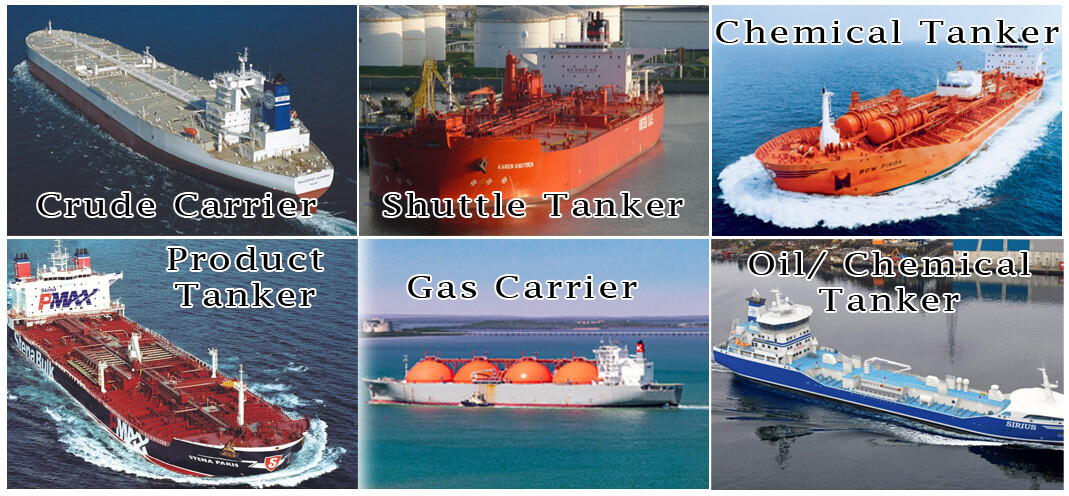
13. Chemical Tankers
These are ships specifically designed to carry liquid chemicals in bulk. We can define which of these are chemicals in Chapter 17 of the IBC Code (International Bulk Chemical Code).
Chemical tankers have high standards. Their design and material enable them to transport even the most dangerous and sensitive cargoes.
These aren’t just normal products but require stringent measures for handling and tank cleaning.
Their tanks are usually made of stainless steel which can withstand corrosive cargoes. Some cargoes are very toxic even a drop on your skin will send you to a hospital.
14. Oil/ Chem Tankers
Some tankers are capable of carrying different grades of petroleum products and a few classes of chemicals.
Their tanks may be coated but there are certain chemicals that are mild enough not to destroy them.
We call these types of merchant ships oil/ chemical tankers. Various authorities certify their tank cleaning and cargo handling equipment to handle carrying oil and chemicals.
Ships like this are at an advantage as they are able to shift between cargoes depending on the market demand.
The only challenge here is the tank cleaning operation wherein it could take days or weeks especially when changing types of cargo.
15. Gas Tankers
Certain gaseous chemicals remain in liquefied form when pressurized or reduced to an extremely low temperature.
Picture this. A 600-liter gas can be brought down to 1 liter in liquefied form. This makes them viable for sea transport.
Gas tankers or gas carriers are further categorized into five sub-types each having certain carriage requirements. These are the following:
- Fully Pressurized
- Semi-pressurized
- Ethylene and Gas/Chem Carriers
- Fully Refrigerated LPG
- Liquefied Natural Gas (LNG)
- Compressed Natural Gas (CNG)
Passenger Ships
Another category of merchant vessels is the passenger type. They carry people in exchange for payment.
Going back to its definition, a merchant ship is a craft used for trading, transporting, and carrying cargo or passengers for a fee over bodies of water
So yes. Passenger ships are merchant ships.
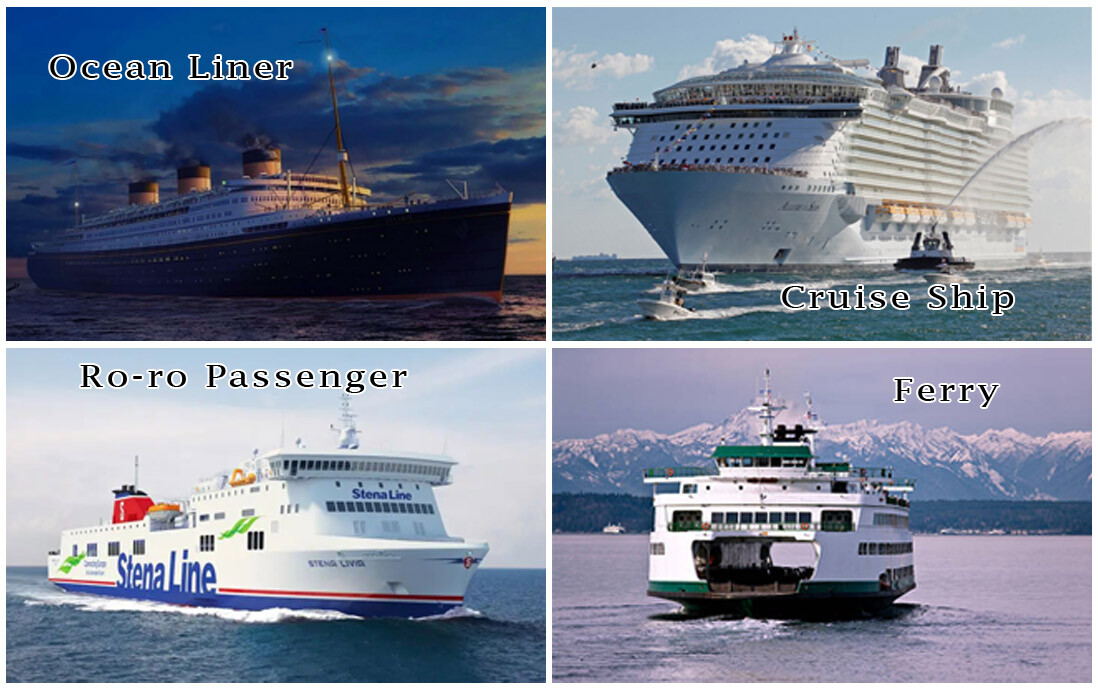
16. Ocean Liners
Ocean liners are similar to cruise ships but vary in their priorities. Liners value speed rather than luxury for their trips.
They were built mostly for trans-oceanic voyages between Europe and the US or even to South America and Asia.
However, they are slowly being replaced by commercial aircraft transport. This enabled the cruise industry to flourish.
17. Cruise Ships
These types of passenger vessels carry people in luxurious experiences. Cruise ships value amenities more than speed as opposed to ocean liners.
They have more stops along many interesting ports before their trans-oceanic passage.
Additionally, cruise vessels are famous for holiday trips, relaxation, excursions, tours, and vacations.
Many people like to work on cruise ships in order to get a “free ride” on the most touristic spots while getting paid for it.
But they must first find reputable cruise ship manning agencies and pass the application process including interviews.
18. Ropax
Ropax is a roll-on/roll-off vessel with the capability of carrying a limited number of passengers.
They have stern ramps for rolling on and off their cargoes either wheeled or non-wheeled.
Additionally, they have access areas for passengers as well as cabins where they can sleep on their short trips.
Many Ro-ro Passenger vessels (Ropax) have fixed routes and tight schedules.
19. Ferries
Sometimes, there is no bridge between two bodies of land separated by water. Or there could be one but is a few hundred kilometers from your place.
Ferries solve this problem. They are ships designed to transport people, vehicles, or even freight over short and fixed routes.
These ships have ramps forward and aft where vehicles can enter and go through without worrying about making a turn.
Ferries usually charge tickets to their passengers on the spot.
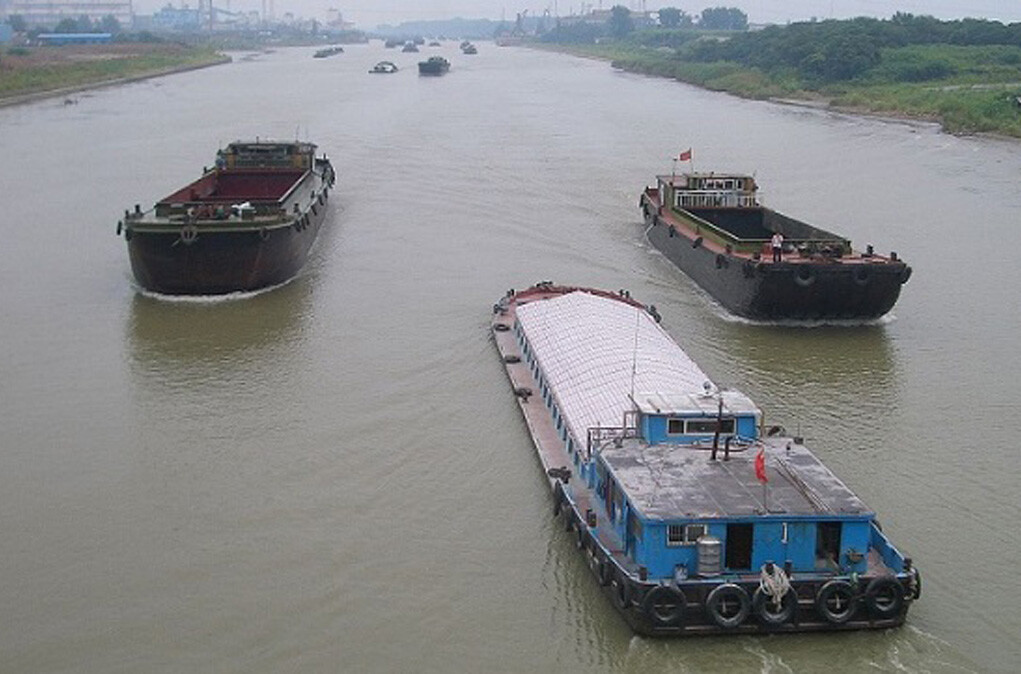
20. Barges
The last type of merchant ships is the barges.
These are small ships carrying different cargoes either wet or dry.
We can see them transporting containers, chemicals, water, bunkers, and even sand.
Construction arrangement is different from seagoing vessels. They have flat bottoms and long decks. These ships can navigate in canals, channels, and rivers.
Due to their small size, they can reach the innermost waterways where large merchant ships cannot.
As we progress into the 21st century, we discover new innovations that make shipping better.
This may well include new breeds of merchant ships and other types of ships as a whole. They may be more efficient and economical.
Who knows really! But in your opinion, which type of merchant ship do you prefer to work at? Tankers, Bulk Carriers or Container Vessels?
May the winds be in your favor.


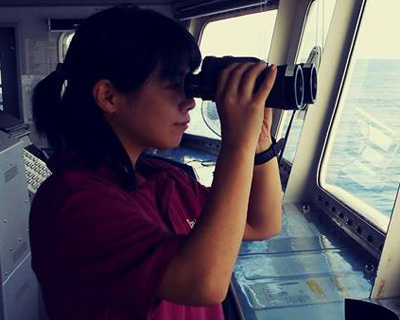
0 Comments